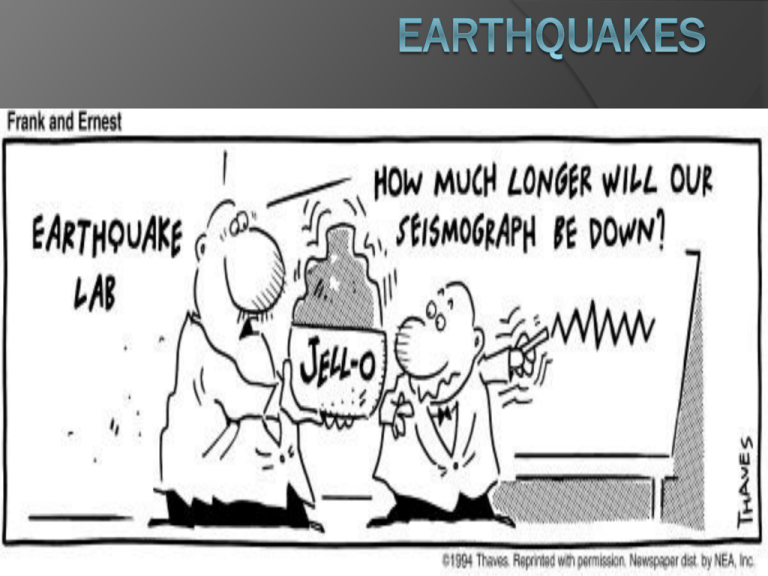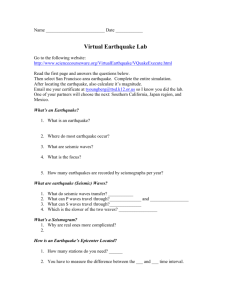Earthquakes 2011
advertisement

Defined Two blocks of the earth’s crust slip past each other after having been stuck together The two pieces are trying to move past one another but the pieces stick together because of friction. The energy trying to push the pieces gets stored. When the pieces finally move (overcome friciton), the stored energy gets released all at once. The energy moves the pieces of crust. This movement is the earthquake. A picture of it… Tokyo 2011 Parts of an Earthquake Focus—the origin of the earthquake; the point of slippage Epicenter—the point on the surface directly above the focus Fault—the plane along which the slipping happens Focal depth—how deep the earthquake occurs The Energy Released Is in the form of waves. Radiates outward in all directions from a central point like ripples in a pond the energy travels through the Earth and along the surface of the earth after an earthquake These waves cause the earth movements that you feel during an earthquake Types of Seismic Waves Body waves P-waves—primary waves S-waves—secondary waves Surface waves L-waves—love waves Rayleigh waves General Comparisons Body waves travel through the earth How scientists “know” the outer core of the earth is liquid. S-waves don’t pass through. Seismographs around the world register earthquakes from all over the world. Surface waves travel only the earth’s surface Lessen in intensity the farther away from the epicenter you get Shadow Zone P-waves travel through solid and liquid BUT they bend when the hit liquids (refraction—like a pencil appears bent in water) S-waves only travel through solids A comparison—p waves P-waves travel the fastest. Do the least damage Can travel through solids and liquids Pushes and pulls the particles P-wave animation A comparison—s waves Slower than p-waves Little damage done Move particles perpendicular to direction of wave propagation S-wave animation A comparison—L waves Slower than s-waves Responsible for most of the damage Moves the ground from side to side (produce all horizontal motion) L-waves animation A comparison—Rayleigh waves Slowest moving wave Responsible for most of the damage (with love waves) Waves roll the ground up-and-down and side-to-side Responsible for most of the shaking Rayleigh wave animation How Big was it? Depends on the size of the fault and the amount of slippage Magnitude is size of the earthquake. Measured on the Richter scale Tells “how much slippage” occurred Sometimes described with intensity as well Measured on the Modified Mercalli scale Richter Scale Measures the amplitude of the wave shaking the earth Logarithmic scale Each number increase = 10 times bigger amplitude of shaking and 32 times more energy released Eureka CA 9 jan 2010 6.5 magnitude http://www.latimes.com/news/local/la-me-eurekaquake-pictures,0,7163381.photogallery http://www.latimes.com/news/local/la-me-eurekaquake-pictures,0,7163381.photogallery Port-a-Prince, Haiti 12 january 2010 7.0 magnitude 3 times stronger than Eureka http://www.boston.com/bigpicture/2010/01/earthquake_in_haiti.html Why so much more damage? http://www.boston.com/bigpicture/2010/01/earthquake_in_haiti.html Sichuan Province, China Magnitude 8.0 May 2008 http://media.theaustralian.com.au/multimedia/2008/05/13-quake/index.html http://media.theaustralian.com.au/multimedia/2008/05/13-quake/index.html Japan, 3 mar 2011, magnitude 8.9 Japan Earthquake http://www.boston.com/bigpicture/2011/03/massive_earthquake_hits_japan.html http://www.boston.com/bigpicture/2011/03/massive_earthquake_hits_japan.html http://www.boston.com/bigpicture/2011/03/massive_earthquake_hits_japan.html A seismograph Shows the amount the surface of the earth moves on a seismograph Due to inertia the weight doesn’t move. The paper moves under the weight. The bigger the squiggle, the bigger the quake http://earthquake.usgs.gov/learn/kids/eqscience.php Modified Mercalli Scale Measures the effect of the earthquake on an area Subjective—no mathematical basis Arbitrary rating based on observations Associated Hazards Landslides Liquefaction Volcanic Eruptions Tsumanis Liquefaction Saturated soil becomes unstable due to the shaking of the earth. Loses its strength and stability More likely in sand soils Liquefaction Japan—11 mar 2011 http://www.boston.com/bigpicture/2011/03/massive_earthquake_hits_japan.html Japan http://www.boston.com/bigpicture/2011/03/massive_earthquake_hits_japan.html http://www.boston.com/bigpicture/2011/03/massive_earthquake_hits_japan.html http://www.boston.com/bigpicture/2011/03/massive_earthquake_hits_japan.html Tsunami Formation Finding the Epicenter Measure the S-P times on seismograms for 3 different locations and record the times Determine the distance for each S-P time from the travel time curves Triangulate using circles—the epicenter is where the 3 intersect. Time Travel Curve Triangulation Any questions?







